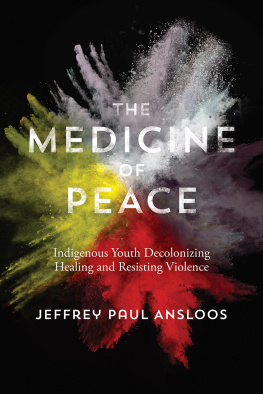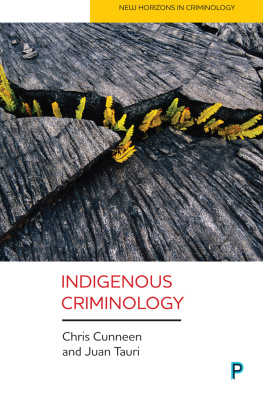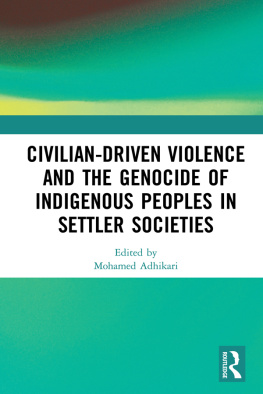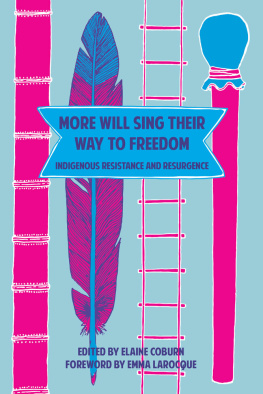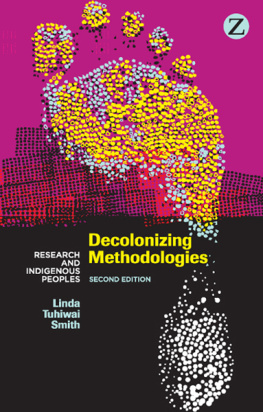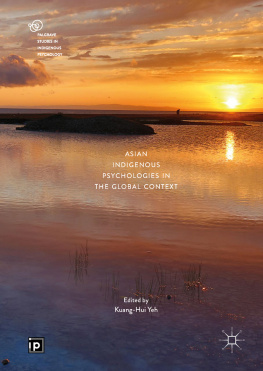THE
MEDICINE
OF
PEACE
THE
MEDICINE
OF
PEACE
Indigenous Youth Decolonizing Healing and Resisting Violence
JEFFREY PAUL ANSLOOS
FERNWOOD PUBLISHING
HALIFAX & WINNIPEG
Copyright 2017 Jeffrey Paul Ansloos
All rights reserved. No part of this book may be reproduced or transmitted in any form by any means without permission in writing from the publisher, except by a reviewer, who may quote brief passages in a review.
Editing: Jessica Antony
Cover design: John van der Woude
Printed and bound in Canada
eBook: tikaebooks.com
Published by Fernwood Publishing
32 Oceanvista Lane, Black Point, Nova Scotia, B0J 1B0
and 748 Broadway Avenue, Winnipeg, Manitoba, R3G 0X3
www.fernwoodpublishing.ca
Fernwood Publishing Company Limited gratefully acknowledges the financial support of the Government of Canada through the Canada Book Fund, the Manitoba Department of Culture, Heritage and Tourism under the Manitoba Publishers Marketing Assistance Program, the Province of Manitoba, through the Book Publishing Tax Credit, the support of the Province of Nova Scotia through the Department of Communities, Culture and Heritage and the support of the Canada Council for the Arts.

Library and Archives Canada Cataloguing in Publication
Ansloos, Jeffrey Paul, 1987-, author
The medicine of peace : indigenous youth decolonizing healing and resisting violence / Jeffrey Paul Ansloos.
Includes bibliographical references and index.
Issued in print and electronic formats.
ISBN 978-1-55266-955-6 (softcover).--ISBN 978-1-55266-956-3 (EPUB).--
ISBN 978-1-55266-957-0 (Kindle)
1. Native youth--Canada--Social conditions. 2. Native youth--Care--Canada. 3. Native peoples--Violence against--Canada. 4. Native peoples--Colonization--Canada. 5. Healing--Social aspects--Canada. I. Title.
E98.Y68A57 2017 305.23508997071 C2016-908067-6
C2016-908068-4
CONTENTS
This book is dedicated to Lisa Dawn, with dreams that feel like prayers.
ACKNOWLEDGEMENTS
I would like to thank my mentors, Alvin Dueck, Winston Gooden, Erin Dufault-Hunter, Cynthia Eriksson, Alexis Abernethy and the late Glen Stassen, for their role in the development of this book. My research was in part made possible through funding from the Fisher River Cree Nation Board of Education, the Max DePree Center for Leadership and the Travis Research Institute. I want to offer special thanks to my colleagues and students at University of Victoria, Lesley University and Canadian Mennonite University who have provided helpful feedback and deep critical engagement in this work. I especially want to offer thanks to Jennifer White, Shanne McCaffrey, Christine and Aja Cy, Deanna Zantingh, Catherine Koverola, Bailey Ray and Laurie Cozad. I also want to offer my gratitude to the team at Fernwood, especially my editor Jessica Antony, for your patience, support, curiosity and kindness. This work would not have been possible without the support, encouragement and kindness of my parents, Paul and Sherry, my grandparents, William Gray, Kelli Penner, Zach Smith, Michael Glowasky, Sarah Moon, Rebekah Kilman, Barbod and Molly Salimi, Blair Gore, Kaela and Justin Napier, and Jeremy and Candace Postal. Finally, thank you for the lives, struggles and enduring love of my Kokum Selena, Nama Shirley and Nampa Ross, Grandpa Joe and Grandma Linkler, Nanna Joan and Papa Steve, Babushka Christina and Grand-daddy Ken, Grandma Yoda Lavallie, Nana Pool Nellie and the dearly departed Grandad Joey, Mumsie and Oma. There are worlds between us all and yet, somehow, you are together, always with me.
PREFACE
All that we are is story. From the moment we are born to the time we continue on our spirit journey, we are involved in the creation of the story of our time here. It is what we arrive with. It is all we leave behind. We are story. All of us. What comes to matter then is the creation of the best possible story we can while were here; you, me, us, together. When we can do that and we take the time to share those stories with each other, we get bigger inside, we see each other, we recognize our kinship we change the world, one story at a time. (Wagamese 2012)
I come to this work with a story. And it is the story of my people that gives this work spirit. So I begin my story by saying tansi, wahkohtowin and peace be with you . Tansi is a Cree greeting that means hello. The word wahkohtowin refers to all of my relations. Peace be with you is a historic Christian greeting meant to convey the love of the Creator. Together these words form the basis of the work ahead. We must encounter one another, recognize our kinship and bestow on one another the dignity of kinship, the medicine of peace.
My name is Jeffrey Paul Ansloos. I am the son of Sherry Lynne Marie Thompson, or by her birth name, Lisa Dawn Stevenson, who is the daughter of both nhkom (Cree for my grandmother) Selena and my German grandmother Shirley Thompson. My grandmother Shirley is a wonderfully kind woman raised by my great grandparents, German immigrants who settled in southern Manitoba, Canada, in the early 1900s. This part of Canada was largely settled by an ethno-religious group called the Mennonites, who had for generations been persecuted in Europe for their commitment to a life of peace demonstrated through nonviolence. This religious group created a strong sense of community life in southern Manitoba through the sharing of resources, providing a strong sense of identity as pacifists, and by promoting a community that was concerned with issues of social justice around the world. That said, the Mennonites also struggled significantly in their relations with Indigenous peoples. Their settlement displaced many Indigenous nations, especially Mtis people. This religious community profoundly shaped the values of my family. When my grandmother was in her mid-twenties during the late 1960s, she and my grandfather Ross pursued the adoption of an 18-month-old Cree girl, my mother.
Nhkom Selena was originally from a reserve in central Manitoba called Fisher River Cree Nation. Selenas mother died when she was very young. Her father was a fisherman. When nhkom was in her early teens she was sent to a residential school in Brandon, Manitoba, that was a six-hour drive from Fisher River to be given primary and secondary schooling by the Ministry of Indian Affairs. Like hundreds of residential schools across North America, there have been legal actions that have demonstrated that there was pervasive abuse of Indigenous children in the Brandon residential school. Abuse that took place in these schools happened on a variety of levels. This is a sad and painful part of our history that I will discuss as best as I can in this book. Needless to say, it is part of the reason why, for many years, my mother and I were disconnected from our identity as Cree people.
In her late teens, Selena became pregnant and, as a young woman, felt compelled to let my mother be raised by another family with more resources and opportunities. My mother was put into the Manitoba adoption agency that primarily provided adoption for Indigenous children throughout the 1960s and 1970s. Neither my mother nor I met Selena until 1998 when we were repatriated with her and our other family members. The day I met nhkom was difficult, yet beautiful. It is always hard to face pain and understand the implications of peoples sacrifice. Facing pain is always a risk too. The outcome is never certain. However, healing rarely comes without risking.

